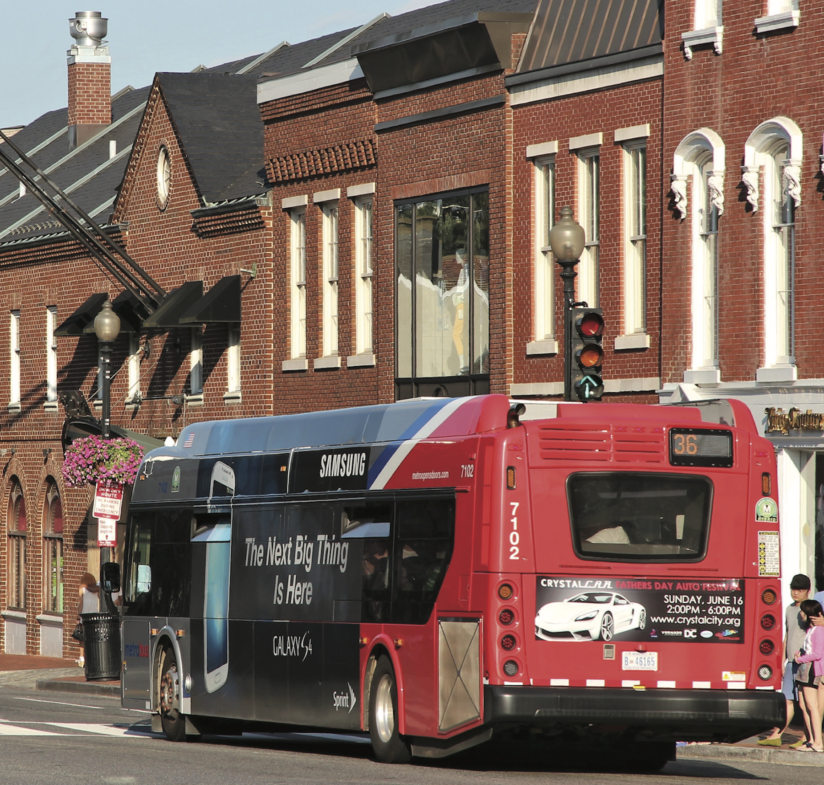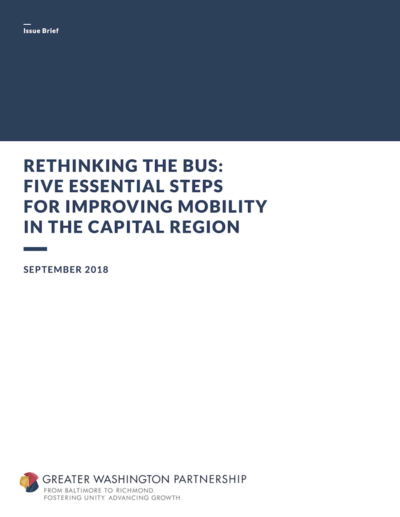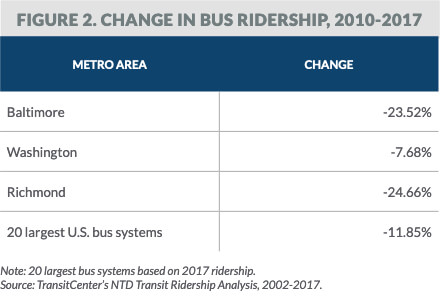Rethinking The Bus: Five Essential Steps For Improving Mobility In The Capital Region
Publish Date: September 2018

 Download Report »
Download Report »
In the Capital Region of Baltimore, Washington, and Richmond, more than ten million people rely on the region’s transportation system every day. But traffic congestion is increasing, commutes are becoming longer and more frustrating, and many people still struggle to access jobs and opportunity reliably and affordably. To address these issues, multiple elements of the transportation network require attention, from improving the performance of key highways to seamlessly connecting our mobility options. Though long overlooked, buses are also a key part of the solution to the region’s mobility challenges.
While there have been notable improvements to bus service in recent years, the region can do more to allow buses to reach their full potential as a mobility solution. All transportation stakeholders—from local and state governments to transit agencies to the private sector—have a role to play in rethinking the bus.
Buses have natural advantages over other types of transportation: they come in many sizes, are affordable and accessible to nearly everyone, and can serve all types of areas. Buses can provide long-distance commuter service or short trips around a city, and they run on existing roads without requiring expensive new infrastructure. In short, buses can be a cost-effective, efficient solution for moving people, particularly in heavily-populated areas.
However, many parts of the United States, including the Capital Region, have not fully valued or maximized the power of the bus. Local and state governments, which own the roads on which buses travel, typically require buses to use the same congested lanes and wait at the same red lights as cars, despite their ability to carry many times more people and offer a viable alternative to single-occupancy vehicles. Bus service has been limited by competing for funding priorities.


Other modes—bikeshare, rail, ride-sharing—have captured the spotlight, engendering regional conversations about strategies and solutions that rarely include buses.
As a result, buses are often the slowest vehicles on the road, and the ride of last resort for many people. It is no wonder that bus ridership has been declining in the Capital Region, mirroring a national trend. (See Figures 1 and 2.)
Slow buses and declining ridership limit the region’s economic potential. Poor service does little to combat traffic congestion, which costs people both time and money. Unreliable public transportation makes it harder for workers to find jobs and for the region’s employers to recruit talent. This in turn undermines the region’s ability to attract new and expanded businesses. While a significant investment has already been made in buses (the region’s bus fleet totals more than 3,800 vehicles3), as a whole, the region has not fully leveraged the potential of this important asset to help solve mounting transportation challenges.
It’s time for the Capital Region to rethink the bus. The region needs buses that are fast, reliable, and frequent. Riding the bus should be easy and convenient and the experience should be comfortable, safe, and modern. Capital Region consumers should be able to count on buses to take them where they need to go, not leave them waiting at the stop. Buses should be treated as a valued part of the transportation system and empowered to effectively serve the needs of consumers in the region.
There are some promising changes already in place, and other efforts are underway. The Greater Richmond Transit Company (GRTC) recently launched the Pulse, the longest bus rapid transit (BRT) line in the Capital Region and the Richmond metro area’s first BRT service, as well as a complete redesign of routes within the city. The Maryland Transit Administration (MTA) implemented a major redesign of Baltimore’s bus routes to increase frequency on major corridors and improve reliability. Residents and visitors in Washington are enjoying faster service on the region’s limited-stop MetroExtra and Metroway bus routes, and the Washington Metropolitan Area Transit Authority (WMATA) is moving forward on implementation of its Priority Corridor Network and also launching study, with regional stakeholders, to better define the role of bus in the region.
Still, there is more that can be done, as other regions have shown. Seattle has used a combination of dedicated bus lanes, priority movement for buses at key intersections, higher frequency on its most popular routes, and faster fare payment to make its buses faster, more reliable, more accessible, and easier to use. Seattle’s bus ridership has continued to grow—up 16 percent since 20104—while most other bus systems are shedding riders.
Houston recently completed a comprehensive set of route changes to provide high-frequency bus service to thousands more residents, with limited impact on its annual budget. Since the change took effect, Houston’s bus ridership has been steady while other Texas cities have lost riders.
Over a decade ago, Seoul’s leaders responded to increasing traffic congestion and declining bus ridership with a series of reforms, including route redesigns, fare payment changes, and bus priority treatments. Bus speeds during peak periods increased 30 percent following the reforms, and ridership increased by more than 10 percent.6 Seoul’s bus system is now recognized as one of the fastest, most convenient, and most reliable in the world.
The Capital Region’s bus systems are already working hard, providing more than 900,000 trips each weekday. But the region has been slow to adopt best practices for bus service across the entire system. The entire Capital Region has just 12.5 miles of dedicated bus lanes. There are just over 300 intersections enabled with transit signal priority (TSP) out of the thousands of intersections used by buses in the region. Richmond’s new Pulse BRT is the only bus service in the region that allows off-board fare payment to speed boarding.
Creating a high-performing bus network is a shared responsibility. Transit agencies, local and state officials, employers and employees, and the community must work together to fully leverage the region’s bus systems and lay the groundwork for future success. That strategy must address five key actions, which can be undertaken immediately and at a far lower cost than most major road or rail projects:
This brief offers recommendations specific to each metro area, to help them build upon the progress that has already been made while encouraging the region to continue to rethink the bus.